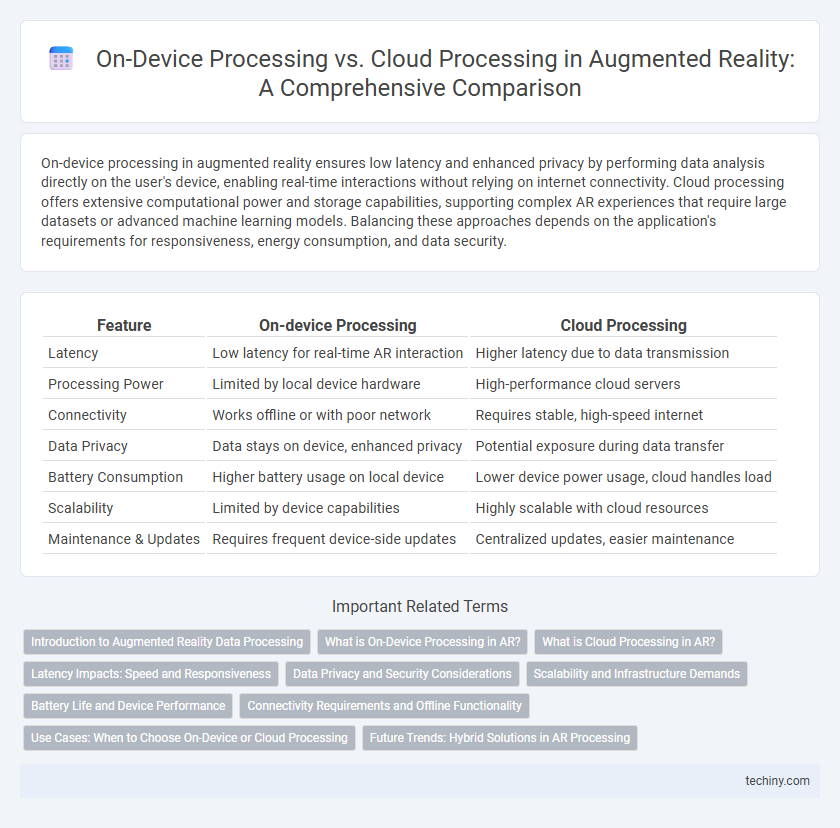On-device processing in augmented reality ensures low latency and enhanced privacy by performing data analysis directly on the user's device, enabling real-time interactions without relying on internet connectivity. Cloud processing offers extensive computational power and storage capabilities, supporting complex AR experiences that require large datasets or advanced machine learning models. Balancing these approaches depends on the application's requirements for responsiveness, energy consumption, and data security.
Table of Comparison
| Feature | On-device Processing | Cloud Processing |
|---|---|---|
| Latency | Low latency for real-time AR interaction | Higher latency due to data transmission |
| Processing Power | Limited by local device hardware | High-performance cloud servers |
| Connectivity | Works offline or with poor network | Requires stable, high-speed internet |
| Data Privacy | Data stays on device, enhanced privacy | Potential exposure during data transfer |
| Battery Consumption | Higher battery usage on local device | Lower device power usage, cloud handles load |
| Scalability | Limited by device capabilities | Highly scalable with cloud resources |
| Maintenance & Updates | Requires frequent device-side updates | Centralized updates, easier maintenance |
Introduction to Augmented Reality Data Processing
Augmented reality data processing involves transforming real-world inputs into interactive digital experiences, with on-device processing performing computations locally on AR hardware for low latency and enhanced privacy. Cloud processing leverages remote servers to handle complex data analysis and rendering, enabling more powerful performance and scalability but introducing potential latency and connectivity dependencies. Balancing on-device and cloud processing optimizes AR applications by delivering responsive user experiences while harnessing advanced computational resources.
What is On-Device Processing in AR?
On-device processing in augmented reality (AR) refers to the execution of AR computations directly on the user's device, such as smartphones, AR glasses, or tablets, without relying on external cloud servers. This approach enables real-time data analysis, faster response times, and improved privacy by minimizing data transmission. Key technologies involved include dedicated AR chipsets, neural processing units (NPUs), and optimized algorithms for sensor fusion and computer vision.
What is Cloud Processing in AR?
Cloud processing in augmented reality (AR) involves leveraging remote servers to handle complex computations, data storage, and rendering tasks, enabling real-time AR experiences without burdening local devices. It allows for scalable processing power, seamless updates, and extensive data analytics by transmitting sensor data and user inputs over the internet to cloud infrastructure. This approach supports multi-user AR environments and high-fidelity graphics while minimizing latency through optimized data streaming and edge computing integration.
Latency Impacts: Speed and Responsiveness
On-device processing in augmented reality significantly reduces latency by performing computations locally, resulting in faster response times and smoother user interactions. Cloud processing, while offering greater computational power, often suffers from increased latency due to data transmission delays, which can negatively affect real-time responsiveness. Optimizing AR applications for low-latency on-device processing enhances speed and overall user experience by minimizing reliance on network connectivity.
Data Privacy and Security Considerations
On-device processing in augmented reality significantly enhances data privacy by keeping sensitive user information local, reducing exposure to network vulnerabilities commonly associated with cloud processing. Cloud processing, while offering scalable computational power and real-time data synchronization, introduces risks such as data interception and unauthorized access during transmission and storage. Prioritizing on-device processing mitigates security concerns by minimizing data transfer, aligning with stringent privacy regulations like GDPR and CCPA, and enabling more secure AR experiences.
Scalability and Infrastructure Demands
On-device processing in augmented reality reduces latency and enhances user privacy by handling data locally, but it faces scalability limitations due to hardware constraints and battery consumption. Cloud processing offers greater scalability by leveraging powerful remote servers to manage complex computations and large datasets, though it relies heavily on stable, high-bandwidth network infrastructure. Balancing these approaches involves optimizing infrastructure demands while maintaining seamless AR experiences at scale.
Battery Life and Device Performance
On-device processing in augmented reality significantly enhances battery life by minimizing constant data transmission to the cloud, reducing energy-consuming network usage. It also improves device performance through low-latency computations, enabling real-time interactions without reliance on external servers. Cloud processing, while offloading heavy computations, often leads to higher battery drain and latency, impacting user experience in battery-sensitive AR applications.
Connectivity Requirements and Offline Functionality
On-device processing in augmented reality significantly reduces dependency on continuous internet connectivity by enabling AR experiences to function smoothly offline, ensuring low latency and real-time responsiveness. In contrast, cloud processing requires stable and high-bandwidth connections to stream data and perform complex computations remotely, which can lead to delays and degraded user experience in areas with poor connectivity. Balancing these approaches optimizes AR performance by leveraging local processing for core tasks while utilizing cloud resources for advanced analytics and storage when connectivity permits.
Use Cases: When to Choose On-Device or Cloud Processing
On-device processing in augmented reality excels in applications requiring low latency and offline functionality, such as real-time object recognition in industrial maintenance or AR gaming experiences where immediate interaction is crucial. Cloud processing suits data-intensive AR use cases like large-scale spatial mapping and collaborative environments, leveraging powerful remote servers for complex computations and seamless multi-user synchronization. Selecting between on-device and cloud processing depends on factors including latency tolerance, connectivity reliability, data privacy requirements, and computational load demands.
Future Trends: Hybrid Solutions in AR Processing
Hybrid AR processing leverages both on-device and cloud resources to enhance performance, reduce latency, and optimize energy efficiency. Future trends emphasize adaptive workload distribution, enabling real-time environment mapping and complex data analytics through seamless integration of edge computing and cloud infrastructure. This approach supports scalable AR applications with improved user experience and responsiveness.
On-device Processing vs Cloud Processing Infographic

 techiny.com
techiny.com